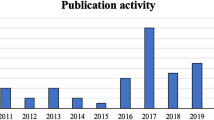Abstract
This study quantitatively reviews the empirical studies of negative political advertising. A method of the combination of citation analysis and content analysis is used. The citation analysis examines each cited work in 20 selected studies with respect to its citation information; and the content analysis investigates these 20 selected studies (citing sources) in terms of their hypotheses, research questions, and methodologies. The aggregated information from the individual cited works and the citing works show that scholars from communication and other disciplines have strong influence on the development of the empirical studies on negative political ads, but communication scholars remain as the driving force. Facing continuously increased literatures in the area, communication scholars need to develop a theory or theories to guide the research. The direction of the research has been moving toward focusing on the boarder and more general effects of negative political ads.
Similar content being viewed by others
References
Bagby, M. R., Parker, J. D., Bury, A. S., (1990). A comparative citation analysis of attribution theory and the theory of cognitive dissonance.Personality and Social Psychology Bulletin, 16, 274–283.
Chubin, D. E., Moitra, S. D., (1975). Content analysis of references: Adjunct or alternative to citation counting?Social Studies of Science, 5, 423–441.
Cox, B. J., Wessel, I., Norton, G. R., Swinson, R. P., (1994). Citation patterns in anxiety disorders research in 14 journals: 1990–1991.American Journal of Psychiatry, 151, 933–936.
Devlin, L. P., (1993). Contrasts in presidential campaign commercials of 1992.American Behavioral Scientist, 37, 270–290.
Egghe, L., Rousseau, R., (1990).Introduction to Informetrics: Quantitative Methods in Library, Documentation and Information Science, Amsterdam, The Netherlands: Elsevier.
Garramone, G. M., (1984). Voter responses to negative political ads.Journalism Quarterly, 61, 250–259.
Garramone, G. M., (1985). Effects of negative political advertising: The roles of sponsor and rebuttal.Journal of Broadcasting & Electronic Media, 29, 147–159.
Gronbeck, B. E., (1992). Negative narrative in 1988 presidential campaign ads.Quarterly Journal of Speech, 78, 333–346.
Holsti, O., (1969).Content Analysis for the Social Sciences and Humanities, Reading, MA: Addison-Wesley.
Johnston, A., (1990). Trends in political communication: a selective review of research in the 1980s. In:D. Swanson, D. Nimmo (Eds),New Directions in Political Communication: A Resource Book, (pp. 329–362). Newbury Park, CA: Sage.
Kaid, L. L., Sanders, K. R., (1985). Survey of political communication theory & research. In:K. R. Sanders, L. L. Kaid, D. Nimmo (Eds),Political Communication Yearbook 1984, (pp. 283–308). Carbondale, IL: Southern Illinois University Press.
Kaid, L. L., Johnston, A., (1991). Negative versus positive television advertising in U.S. presidential campaigns, 1960–1988.Journal of Communication, 41, 53–64.
Lievrouw, L. A., (1988). Four programs of research in scientific communication.Knowledge in Society, 1(2), 6–22.
Magyar, G., (1974). Bibliometric analysis of a new research sub-field.Journal of Documentation, 31, 32–40.
Nimmo, D., Sanders, K. R., (1981). Introduction: The emergence of political communication as a field. In:D. Nimmo, K. Sanders (Eds),Handbook of Political Communication, (pp. 11–36). Beverly Hills: Sage.
Pfau, M., Parrott, R., Lindquist, B., (1992). An expectancy theory explanation of the effectiveness of political attack television spots: A case study.Journal of Applied Communication Research, 20, 235–253.
Reid, E. F., (1983).An Analysis of Terrorism Literature: A Bibliometric and Content Analysis Study. University of Southern California: Dissertation.
Reeves, B., Borgman, C. L., (1983). A bibliometric evaluation of core journals in communication research.Human Communication Research, 10, 119–136.
Rice, R. E., Borgman, C. L., Reeves, B., (1988). Citation networks of communication journals, 1977–1985.Human Communication Research, 15, 256–283.
Roche, T., Smith, D. L., (1978). Frequency of citations as criterion for the ranking of departments, journals, and individuals.Sociological Inquiry, 48, 49–57.
Sarabia, M. Z. T., (1993).Citation Analysis and the Impact of Journalism and Mass Communication Publication (1970–1990). Dissertation, Oklahoma State University.
So, C. Y. K., (1988). Citation patterns of core communication journals: An assessment of the developmental status of communication.Human Communication Research, 15, 236–255.
Sengupta, I. N., Kumar, L., (1991). Bibliometric analysis of AIDS Literature.Scientometrics, 20, 297–315.
Small, H., Greenlee, E., (1989). A co-citation study of AIDS research.Communication Research, 16, 642–666.
Summers, E., (1984). A review and application of citation analysis methodology to reading research journal literature.Journal of the American Society for Information Science, 35, 332–343.
Trent, J. S., Sabourin, T., (1993). Sex still counts: Women's use of televised advertising during the decade of the 80's.Journal of Applied Communication Research, 21, 21–40.
Wispe, L., Osborn, C., (1982). Citation patterns in communication: A study of interdisciplinary influences.Association for Communication Administration Bulletin, 42, 32–39.
Author information
Authors and Affiliations
Rights and permissions
About this article
Cite this article
Lin, Y. Empirical studies of negative political advertising: A quantitative review using a method of combined citation and content analysis. Scientometrics 37, 385–399 (1996). https://doi.org/10.1007/BF02019254
Received:
Issue Date:
DOI: https://doi.org/10.1007/BF02019254




